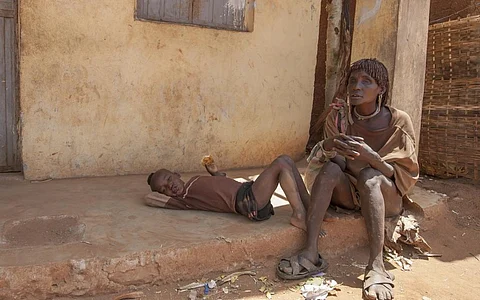

With 9 per cent of the global population (712 million people) living in extreme poverty and 65 per cent of the targets under SDG 2 (ending hunger) have either stagnated or regressed, the High-level Political Forum (HLPF) on Sustainable Development reviewed the goals aimed at addressing poverty and hunger and their relationships with other SDGs.
The delegates examined three of the five sustainable development goals that will be discussed at the forum. The first day of the event included a review of SDG 17, the global partnership for sustainable development, where more than 30 per cent of the targets had either stagnated or declined.
The leaders discussed how these goals intersect with gender issues, conflict, agriculture, the economy, human rights, and failures in the multilateral system. They recognised that the triple planetary crisis of pollution, biodiversity loss, and climate change had exacerbated human vulnerabilities and social costs.
The review of SDG 1 (no poverty), held on July 9, 2024 under the co-chairs Tarek Ladeb, the vice-president of the United Nations Economic and Social Council (ECOSOC) Tunisia, and Bob Rae, the vice-president of ECOSOC Canada, brought attention to the multifaceted nature of poverty. The discussion also covered creative ways to solve crises and end poverty.
The COVID-19 pandemic caused extreme poverty to increase in 2020 for the first time in decades, reversing global progress by three years, according to the UN Secretary-General’s 2024 SDG report introduced by Li Junhua, UN Under-Secretary-General for Economic and Social Affairs (UN DESA) at the event on July 8, 2024.
According to the UN report, the recovery has been uneven, with low-income nations falling behind. Additionally, the lingering polycrisis makes it seem increasingly unlikely that poverty will be eradicated by 2030, especially in areas lacking the financial resources to handle economic strains. Less than 3 out of 10 countries are predicted to halve national poverty by 2030 if there is no significant acceleration in the fight against poverty.
“So, none of the SDG 1 targets are on track for 2030,” reminded Bob Rae, citing the report.
Africa accounts for more than half of the world's impoverished people, making it improbable that the continent can fulfil the aims of SDG 1, according to Rola Dashti of the Economic and Social Commission for Western Asia. This implies that if Africa is left behind, the globe will not advance.
In 2023, 1.4 billion children were not protected by social safety programmes, despite increased efforts and vows to do so. In this regard, Shahra Razavi of the International Labour Organization issued a warning, pointing out that administrative and data errors frequently cause qualified beneficiaries to be excluded from targeted social protection programmes.
Women are disproportionately affected by poverty and advocated for spending to be prioritised in order to meet commitments related to human rights, Ilze Brands Kehris, assistant secretary-general for human rights, underlined.
Germany emphasised the need of integrating economic growth within global frameworks, while Tanzania and Timor Leste demanded measures that address the synergies of the SDGs. The importance of agri-food systems was emphasised by the Food and Agriculture Organization (FAO), notwithstanding obstacles brought about by political unrest and climate change.
Various countries including Brazil and India, shared national initiatives aimed at alleviating poverty, including social and infrastructural services, affordable credit and agriculture support. Brazil, for instance, emphasised the growth of social security programmes that have benefitted over 21 million households since 2022.
Among the developed countries, Germany emphasised the necessity of integrating economic expansion within planetary boundaries, while Switzerland observed that hidden poverty still exists despite its privileged status.
When between 691 and 783 million people faced hunger in 2022 and 2.4 billion people experienced food insecurity, the session on SDG 2 explored the complex linkages between food security and global trends.
UN DESA's Faryal Ahmed emphasised the critical problem of food insecurity, predicting that by 2030, 20 per cent of children under five will be stunted. Moreover, a 10 per cent GDP loss in Africa is attributed to child stunting, highlighted Iain Wright of the High-Level Panel of Experts on Food Security and Nutrition.
According to Lebanese MP Inaya Ezzedine, the right to food should be safeguarded by national and international legal and accountability frameworks. Aline Mosnier of the FABLE Pathways Consortium emphasised the significance of measures to address the hidden costs of unhealthy eating in light of the increased frequency of non-communicable diseases.
Uganda and Thailand emphasised the use of agroecology and related programmes that link agricultural output to better health and nutrition outcomes as well as climate resilience.
“Crop failure has happened in developing countries,” the Zambian delegate added. Staple foods that are susceptible to natural calamities are particularly affected. The delegation recommended that small-scale farmers diversify their products to include more robust meals and obtain prudent insurance.
Aline Mosnier and Iain Wright, vice-chair of the Steering Committee of the High-Level Panel of Experts on Food Security and Nutrition, emphasised the interconnectedness of SDGs 1 and 2, as well as the pressing need for resource mobilisation. The leaders called for funding and investments in nutrition resilience.
The delegates also demanded a halt to the weaponisation of food and water, which were being used as weapons of mass destruction in Gaza.